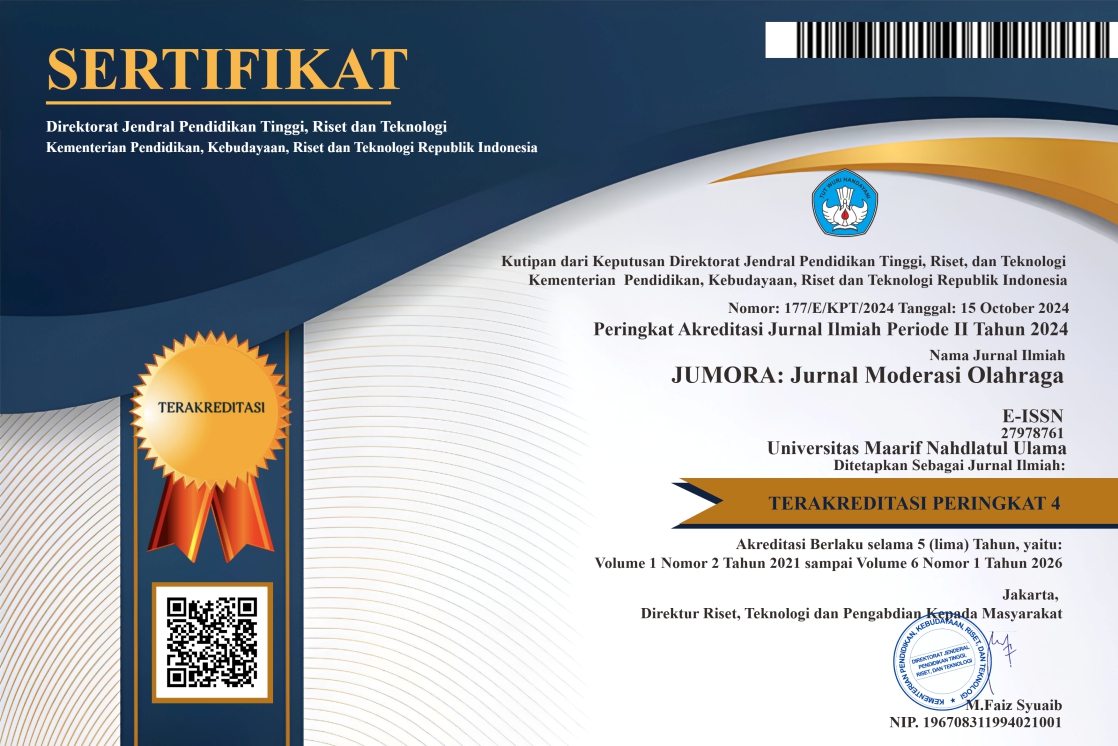Study Habits of Student Athletes at the Faculty of Sports Education and Health, Indonesian University of Education
DOI:
https://doi.org/10.53863/mor.v5i1.1543Keywords:
academic achievements, sports achievements, student athlete, study habitsAbstract
This article aims to explore the learning habits of student athletes at the Faculty of Sports Education and Health, Universitas Pendidikan Indonesia. Student athletes are faced with challenges in managing time between academic and sports activities, which requires effective and efficient learning strategies. This study identifies learning styles, GPA, learning habits, sports achievements, and the time span to prepare for championships and exams. The sample involved in this study were active students of the Faculty of Sports Education and Health who had participated in official matches at least at the provincial level, as many as 90 people. Based on the results of the analysis, most students at the Faculty of Sports Education and Health have quite high academic accountability and need to be improved.
References
Allen, M. S., Robson, D. A., Martin, L. J., & Laborde, S. (2019). Systematic Review and Meta-Analysis of Self-Serving Attribution Biases in the Competitive Context of Organized Sport. Personality and Social Psychology Bulletin, 46, 1027–1043.
Bao-hai, Z. (2011). Analysis and guide of high-level college athletic students’ study behavior. Shandong Sports Science & Technology.
Daing, C., & Sinocruz, F. S. (2022). Study habits and scholastic performance of junior student-athletes in educational district IV. International Journal of Educational Studies in Social Sciences.
Darajat, J., & Abduljabar, B. (2014). Aplikasi Statistika Dalam Penjas. Bandung: CV. Bintang Warliartika.
Dinata, V. C., Priambodo, A., Hariyanto, A., Ristanto, O., & Prakoso, B. (2020). Evaluasi penerapan blended learning berdasarkan kualitas model dan motivasi belajar mahasiswa-atlet Evaluation of the blended learning implementation based on model quality and student-athlete learning motivation PENDAHULUAN Pembalajaran tradisional tatap. 6(2), 407–422.
Grace, M., Garcia, G., & Subia, G. S. (2019). High school athletes: Their motivation, study habits, self-discipline and academic performance. 86 ~ International Journal of Physical Education, Sports and Health, 6(1), 86–90.
Gumilar, A. (2024). The Influence of Learning Problems on the Implementation of Students’ Physical Education Values. International Sport Edelweiss Journal, 1(01), 1–9.
Gumilar, A., Darajat, J., Negara, K., & Firmansyah, H. (2024). Jurnal Patriot Development of digital-based return board table tennis learning media. 6(1), 13–20.
Gumilar, A., Ma’Mun, A., Nuryadi, N., KN, J. D., & Hambali, B. (2023). Kecakapan hidup atlet softball remaja. Jurnal Patriot, 5(4), 177–185.
Jauhari, R., Supriatna, S., Fadhli, N. R., & Roesdiyanto, R. (2022). Hubungan Aktivitas Olahraga dengan Prestasi Akademik pada Atlet Akademi Arema U-14. Sport Science and Health, 4(10), 881–893. https://doi.org/10.17977/um062v4i102022p881-893
Juliantine, T., & Setiawan, E. (2022). Effect of tactical game models on formation of basic techniques in handball players: Mixed method. Physical Education Theory and Methodology, 22(3), 373–378.
Juliantine, T., Setiawan, E., Jumareng, H., Gani, R. A., & Asnaldi, A. (2022). Do Fundamental Movement Skills, Physical Activity and Enjoyment Among Inactive Student During the Covid-19 Era Improve After Exergame? Journal of Physical Education (Maringa), 33(1), 4–11. https://doi.org/10.4025/jphyseduc.v33i1.3327
Lestari, S., & Widda Djuhan, M. (1970). Analisis Gaya Belajar Visual, Audiotori dan Kinestetik dalam Pengembangan Prestasi Belajar Siswa. JIIPSI: Jurnal Ilmiah Ilmu Pengetahuan Sosial Indonesia, 1(2), 79–90. https://doi.org/10.21154/jiipsi.v1i2.250
Negara, J. D. K., Jusman, S. W., Ilyas, E. I., & Sekartini, R. (2019). The Effect of Futsal toward Neuroplasticity (Experiment study on Junior High School). 3rd International Conference on Sport Science, Health, and Physical Education (ICSSHPE 2018), 199–202.
Nowak, D. E. (2018). A meta-analytical synthesis and examination of pathological and problem gambling rates among college athletes. Journal for the Study of Sports and Athletes in Education, 12, 240–257.
Nurman Hasibuan, Syahputra Manik, & Rosmaini Hasibuan. (2022). Hubungan Antara VO2 MAX dengan Indeks Prestasi Kumulatif (IPK) Mahasiswa IKOR FIK UNIMED. DIAJAR: Jurnal Pendidikan Dan Pembelajaran, 1(4), 534–539. https://doi.org/10.54259/diajar.v1i4.1716
Nuryadi, N. (2024). Transisi Karir Atlet: Sebuah Kajian Terhadap Mantan Atlet Sepakbola Nasional.
Nuryadi, N., Jabar, B. A., Negara, J. D. K., Gumilar, A., & Hambali, B. (2021). Student Athlete Rewarding System In Bandung City. Kinestetik: Jurnal Ilmiah Pendidikan Jasmani, 5(4), 777–781.
Nuryadi, Negara, J. D. K., Gumilar, A., Hambali, B., Martini, T., Purnomo, E., & Jajiyah, N. K. (2024). Student-Athlete Non-Academic Performance in Sport Faculty. Retos, 55(Allen 1997), 105–111. https://doi.org/10.47197/RETOS.V55.103756
Riciputi, S., & Erdal, K. (2017). The effect of stereotype threat on student-athlete math performance. Psychology of Sport and Exercise, 32, 54–57. https://doi.org/10.1016/j.psychsport.2017.06.003
Schunk, D. H. (2012). Learning theories an educational perspective. Pearson Education, Inc.
Setiawati, S. M. (2018). Telaah Teoritis: Apa Itu Belajar? HELPER: Jurnal Bimbingan Dan Konseling, 35 (1), 31–46.
Setiyani, L. (2021). Desain Sistem : Use Case Diagram Pendahuluan. Prosiding Seminar Nasional : Inovasi & Adopsi Teknologi 2021, September, 246–260. https://journal.uii.ac.id/AUTOMATA/article/view/19517
Sucipto, Yudiana, Y., Hambali, B., Komariyah, L., & Gumilar, A. (2021). Application of tactical approach to developing students’ enjoyment and skills in playing football. International Journal of Human Movement and Sports Sciences, 9(4), 100–105. https://doi.org/10.13189/saj.2021.091317
Sukmawati, N. P. F., Suarni, N. K., & Renda, N. T. (2013). Hubungan antara efikasi diri dan kebiasaan belajar terhadap prestasi belajar siswa kelas V SDN di Kelurahan Kaliuntu Singaraja. Mimbar PGSD Undiksha, 1(1).
Wahyudi, W. (2022). Analisis Motivasi Belajar Siswa Dengan Menggunakan Model Pembelajaran Blended Learning Saat Pandemi Covid-19 (Deskriptif Kuantitatif Di Sman 1 Babadan Ponorogo). KadikmA, 13(1), 68. https://doi.org/10.19184/kdma.v13i1.31327
Wijaya, S. A., & Saputri, S. D. (2019). Pengaruh kebiasaan belajar terhadap prestasi belajar siswa. Ekuitas: Jurnal Pendidikan Ekonomi, 7(2), 117–121.
Downloads
Published
How to Cite
Issue
Section
License
Copyright (c) 2025 Farisha Hasna Arrumaisha, Nuryadi Nuryadi, Tite Juliantine, Agus Gumilar

This work is licensed under a Creative Commons Attribution-ShareAlike 4.0 International License.
Authors retain copyright and grant the journal right of first publication with the work simultaneously licensed under a Creative Commons Attribution-ShareAlike 4.0 International License that allows others to share the work with an acknowledgment of the work’s authorship and initial publication in this journal











